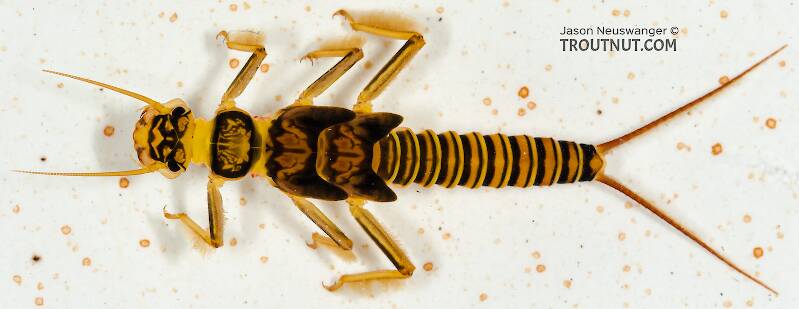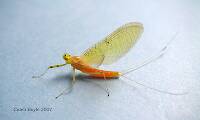
Hex Mayflies
Hexagenia limbata
The famous nocturnal Hex hatch of the Midwest (and a few other lucky locations) stirs to the surface mythically large brown trout that only touch streamers for the rest of the year.
Featured on the forum

This species was fairly abundant in a February sample of the upper Yakima.

Troutnut is a project started in 2003 by salmonid ecologist Jason "Troutnut" Neuswanger to help anglers and
fly tyers unabashedly embrace the entomological side of the sport. Learn more about Troutnut or
support the project for an enhanced experience here.

This large Perlodidae stonefly was a strikingly bright yellow color, more so than any other insect I've seen. I didn't enhance it much. See the discussion threads to follow how we identified this specimen, which was listed incorrectly for several years.
Taxon on Jul 7, 2006July 7th, 2006, 7:49 am EDT
Jason-
Not to despair; this is what American Stoneflies: A Photographic Guide to the Plecoptera by Bill P. Stark, Stanley W. Szezytko, and C. Ridley Nelson has to say about genus Arcynopteryx:
"This genus is represented in North America by A. compacta (McLachlan). This species ranges from Alaska to Maine and has been reported as far south as Colorado. Males usually have shortened wings and are easily recognized by the long, lash-like epiproct tip. Females and nymphs are quite similar to Skwala. A. compacta has been collected around alpine lakes in the northern Rocky Mountains. No photographs are available for this group."
Also, Arcynopteryx compacta is listed by Stark/Baumann as residing in New York.
Not to despair; this is what American Stoneflies: A Photographic Guide to the Plecoptera by Bill P. Stark, Stanley W. Szezytko, and C. Ridley Nelson has to say about genus Arcynopteryx:
"This genus is represented in North America by A. compacta (McLachlan). This species ranges from Alaska to Maine and has been reported as far south as Colorado. Males usually have shortened wings and are easily recognized by the long, lash-like epiproct tip. Females and nymphs are quite similar to Skwala. A. compacta has been collected around alpine lakes in the northern Rocky Mountains. No photographs are available for this group."
Also, Arcynopteryx compacta is listed by Stark/Baumann as residing in New York.
Troutnut on Jul 7, 2006July 7th, 2006, 8:08 am EDT
Thanks! It's probably A. compacta then. I like the genus name.
Jason Neuswanger, Ph.D.
Troutnut and salmonid ecologist
Troutnut and salmonid ecologist
Myersl on Apr 8, 2010April 8th, 2010, 3:26 am EDT
Jason,
This appears to be Cultus verticalis, although without examining the actual specimen or seeing adults, I can’t be sure. The color pattern is very striking in comparison to nymphs preserved in ethanol. I have collected adults of Cultus verticalis and Cultus decisus decisus from several streams in the Catskills. There are two species of Cultus in New York, Cultus decisus decisus (in large rivers) and Cultus verticalis (in small to medium sized streams). Arcynopteryx compacta is very uncommon in NY.
This appears to be Cultus verticalis, although without examining the actual specimen or seeing adults, I can’t be sure. The color pattern is very striking in comparison to nymphs preserved in ethanol. I have collected adults of Cultus verticalis and Cultus decisus decisus from several streams in the Catskills. There are two species of Cultus in New York, Cultus decisus decisus (in large rivers) and Cultus verticalis (in small to medium sized streams). Arcynopteryx compacta is very uncommon in NY.
myersl
Entoman on Nov 9, 2011November 9th, 2011, 12:02 am EST
Great photos, Jason.
There seems to have been a lot of back and forth on this determination over the years. I stumbled across these conversations while researching something else and quickly became interested. Trying to tie three different threads together back into one conversation is probably impossible, but worth a try. How they got separated in the first place, I have no idea. Anyway, the fortunate thing is that your quality photos teamed up with a good specimen (that shows some key characters unambiguously) makes this fun and worth revisiting.
It's my understanding that one of the most important set of characters helpful in separating out the various genera of the Perlodidae can be found on the mesosternum and somehow they weren't discussed much regarding this specimen. The third photo shows these characters in great detail and I think that's where you went wrong in the M & C keys. In one of the couplets you were given a choice between whether the Y-arms met the anterior or posterior corners of the furcal pits. I think you chose anterior which led you to Arcynopterx and away from Isogenoides. You missed by only one couplet!:)
I think Loyd is right about Isogenoides - the terga and head markings match to a tee. The size is right too. Isogenoides has a median longitudinal suture running from the stem to the transverse suture between the Y-arms creating a three point contact. Your specimen also has this character. The other genera mentioned as possibilities have issues with this and other Y-arm characters as well as the gill character Lloyd mentioned.
Regards,
Kurt
There seems to have been a lot of back and forth on this determination over the years. I stumbled across these conversations while researching something else and quickly became interested. Trying to tie three different threads together back into one conversation is probably impossible, but worth a try. How they got separated in the first place, I have no idea. Anyway, the fortunate thing is that your quality photos teamed up with a good specimen (that shows some key characters unambiguously) makes this fun and worth revisiting.
It's my understanding that one of the most important set of characters helpful in separating out the various genera of the Perlodidae can be found on the mesosternum and somehow they weren't discussed much regarding this specimen. The third photo shows these characters in great detail and I think that's where you went wrong in the M & C keys. In one of the couplets you were given a choice between whether the Y-arms met the anterior or posterior corners of the furcal pits. I think you chose anterior which led you to Arcynopterx and away from Isogenoides. You missed by only one couplet!:)
I think Loyd is right about Isogenoides - the terga and head markings match to a tee. The size is right too. Isogenoides has a median longitudinal suture running from the stem to the transverse suture between the Y-arms creating a three point contact. Your specimen also has this character. The other genera mentioned as possibilities have issues with this and other Y-arm characters as well as the gill character Lloyd mentioned.
Regards,
Kurt
"It's not that I find fishing so important, it's just that I find all other endeavors of Man equally unimportant... And not nearly as much fun!" Robert Traver, Anatomy of a Fisherman
Quick Reply
Related Discussions
Topic
Replies
Last Reply
8
Feb 12, 2009
by Troutnut
by Troutnut
6
Jul 28, 2012
by Entoman
by Entoman






